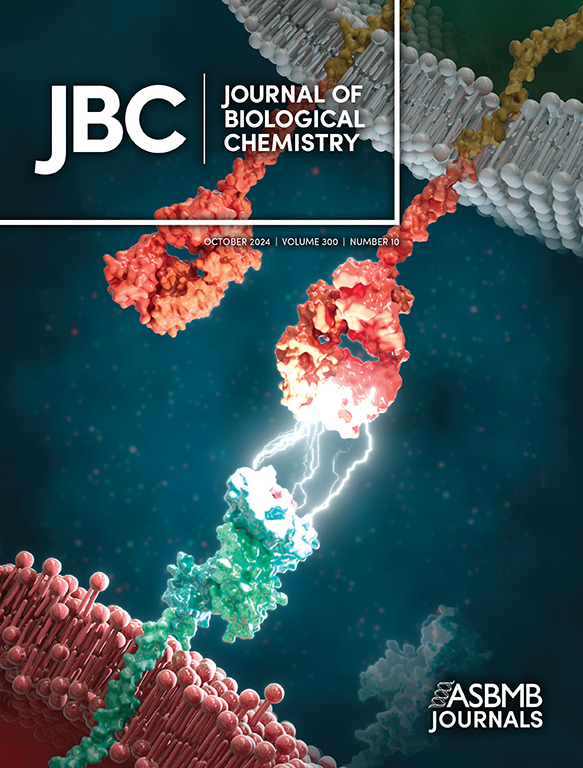Aberrant activation of IL-6/JAK/STAT3/FOSL1 signaling induces renal abnormalities in a Xenopus model of Joubert syndrome-related disorders.
IF 4
2区 生物学
Q2 BIOCHEMISTRY & MOLECULAR BIOLOGY
引用次数: 0
Abstract
CEP290 gene mutations are linked to Joubert syndrome-related disorders (JSRD) which present with various symptoms including brain malformation, retinal degeneration and kidney disorders. It remains unclear how JSRD patients with CEP290 gene mutations lead to kidney disorders, particularly polycystic kidney disease including nephronophthisis (NPH). To address this question, Xenopus CEP290 (xCEP290) was depleted using morpholino oligonucleotides against xCEP290 in Xenopus embryos. xCEP290 morphants exhibited edema and dilated pronephric tubule, indicative of renal dysfunction. Next, RNA-seq analysis was performed to explore which signals and molecules are important for the formation of dilated pronephric tubule observed in the xCEP290 morphant kidney. The hallmark gene set associated with the IL-6/JAK/STAT3 signaling pathway was up-regulated in xCEP290 morphant kidney, and inhibition of this signaling by JAK inhibitor ruxolitinib suppressed the dilated pronephric tubule in xCEP290 morphants. Furthermore, the expression level of transcription factor Xenopus FOSL1 (xFOSL1), whose gene expression is regulated by IL-6 signaling, was up-regulated in xCEP290 morphant kidney, and overexpression of xFOSL1 induced pronephric tubular dilation. These results together revealed that abnormal activation of IL-6/JAK/STAT3/FOSL1 signal axis is responsible for dilated pronephric tubule resembling cystic lesions observed in polycystic kidney disease of JSRD patients with CEP290 gene mutations.在Joubert综合征相关疾病的爪蟾模型中,IL-6/JAK/STAT3/FOSL1信号的异常激活可诱导肾脏异常。
CEP290基因突变与Joubert综合征相关疾病(JSRD)有关,后者表现为各种症状,包括脑畸形、视网膜变性和肾脏疾病。目前尚不清楚伴有CEP290基因突变的JSRD患者如何导致肾脏疾病,特别是多囊肾病(包括肾病)。为了解决这个问题,我们在爪蟾胚胎中使用针对xCEP290的morpholino寡核苷酸对爪蟾CEP290 (xCEP290)进行了修饰。xCEP290突变体表现为水肿和肾原小管扩张,提示肾功能不全。接下来,我们进行RNA-seq分析,以探索在xCEP290变异肾脏中观察到的哪些信号和分子对扩张肾原小管的形成是重要的。与IL-6/JAK/STAT3信号通路相关的标志基因集在xCEP290突变体肾脏中上调,JAK抑制剂ruxolitinib抑制该信号通路可抑制xCEP290突变体肾原小管扩张。此外,受IL-6信号通路调控的转录因子Xenopus FOSL1 (xFOSL1)在xCEP290变异肾中的表达水平上调,xFOSL1的过表达可诱导肾原管扩张。这些结果共同揭示了IL-6/JAK/STAT3/FOSL1信号轴的异常激活是在CEP290基因突变的JSRD多囊肾病患者中观察到的类似囊性病变的肾原管扩张的原因。
本文章由计算机程序翻译,如有差异,请以英文原文为准。
求助全文
约1分钟内获得全文
求助全文
来源期刊

Journal of Biological Chemistry
Biochemistry, Genetics and Molecular Biology-Biochemistry
自引率
4.20%
发文量
1233
期刊介绍:
The Journal of Biological Chemistry welcomes high-quality science that seeks to elucidate the molecular and cellular basis of biological processes. Papers published in JBC can therefore fall under the umbrellas of not only biological chemistry, chemical biology, or biochemistry, but also allied disciplines such as biophysics, systems biology, RNA biology, immunology, microbiology, neurobiology, epigenetics, computational biology, ’omics, and many more. The outcome of our focus on papers that contribute novel and important mechanistic insights, rather than on a particular topic area, is that JBC is truly a melting pot for scientists across disciplines. In addition, JBC welcomes papers that describe methods that will help scientists push their biochemical inquiries forward and resources that will be of use to the research community.
 求助内容:
求助内容: 应助结果提醒方式:
应助结果提醒方式:


